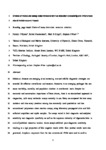Choice of molecular assay determines ranavirus detection probability and inferences about prevalence and occurrence
| dc.contributor.author | Wynne, FJ | |
| dc.contributor.author | Puschendorf, Robert | |
| dc.contributor.author | Knight, Mairi | |
| dc.contributor.author | Price, SJ | |
| dc.date.accessioned | 2020-10-10T20:20:12Z | |
| dc.date.available | 2020-10-10T20:20:12Z | |
| dc.date.issued | 2020-09-24 | |
| dc.identifier.issn | 0177-5103 | |
| dc.identifier.issn | 1616-1580 | |
| dc.identifier.uri | http://hdl.handle.net/10026.1/16520 | |
| dc.description.abstract |
<jats:p>Ranaviruses are emerging pathogens that can cause morbidity, mortality and population declines in ectothermic hosts; however, there is no standardized approach to diagnostics. Here, we compared the inter-assay variation and intra-assay precision among 2 commonly used quantitative PCRs (qPCRs), a conventional and a nested PCR assay (used as a gold standard), using laboratory-propagated ranavirus (FV3 and CMTV) and field-collected samples. A qPCR assay (‘Leung’) detected viral DNA in dilutions 2 orders of magnitude lower than other assays regardless of the viral lineage of the cultured isolate (FV3/CMTV). The second qPCR (‘Brunner’) was slightly more sensitive than the conventional PCR (‘Mao’ assay). For field samples, the Leung qPCR detected all known positives, while the Mao assay PCR only detected 2.5% of the positive samples. Amplicon sequences from the 2 conventional PCRs were shown to be useful for inferring viral lineage. Inaccurate results will bias estimates of the distribution and prevalence of ranaviruses, and together these findings emphasize that molecular assays should be chosen carefully in the context of study aims.</jats:p> | |
| dc.format.extent | 139-147 | |
| dc.format.medium | Electronic | |
| dc.language | en | |
| dc.language.iso | en | |
| dc.publisher | Inter-Research Science Center | |
| dc.subject | Ranavirus | |
| dc.subject | Diagnostic methods | |
| dc.subject | qPCR | |
| dc.subject | Nested PCR | |
| dc.subject | Specificity | |
| dc.subject | Sensitivity | |
| dc.title | Choice of molecular assay determines ranavirus detection probability and inferences about prevalence and occurrence | |
| dc.type | journal-article | |
| dc.type | Journal Article | |
| plymouth.author-url | https://www.webofscience.com/api/gateway?GWVersion=2&SrcApp=PARTNER_APP&SrcAuth=LinksAMR&KeyUT=WOS:000614220300013&DestLinkType=FullRecord&DestApp=ALL_WOS&UsrCustomerID=11bb513d99f797142bcfeffcc58ea008 | |
| plymouth.volume | 141 | |
| plymouth.publication-status | Published | |
| plymouth.journal | Diseases of Aquatic Organisms | |
| dc.identifier.doi | 10.3354/dao03518 | |
| plymouth.organisational-group | /Plymouth | |
| plymouth.organisational-group | /Plymouth/Faculty of Science and Engineering | |
| plymouth.organisational-group | /Plymouth/REF 2021 Researchers by UoA | |
| plymouth.organisational-group | /Plymouth/REF 2021 Researchers by UoA/UoA06 Agriculture, Veterinary and Food Science | |
| plymouth.organisational-group | /Plymouth/Users by role | |
| plymouth.organisational-group | /Plymouth/Users by role/Academics | |
| dc.publisher.place | Germany | |
| dcterms.dateAccepted | 2020-01-01 | |
| dc.rights.embargodate | 2022-1-21 | |
| dc.identifier.eissn | 1616-1580 | |
| dc.rights.embargoperiod | Not known | |
| rioxxterms.versionofrecord | 10.3354/dao03518 | |
| rioxxterms.licenseref.uri | http://www.rioxx.net/licenses/all-rights-reserved | |
| rioxxterms.licenseref.startdate | 2020-09-24 | |
| rioxxterms.type | Journal Article/Review |


